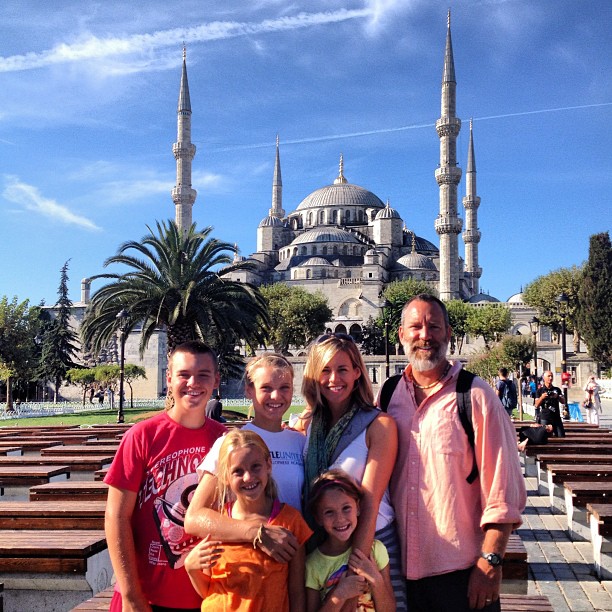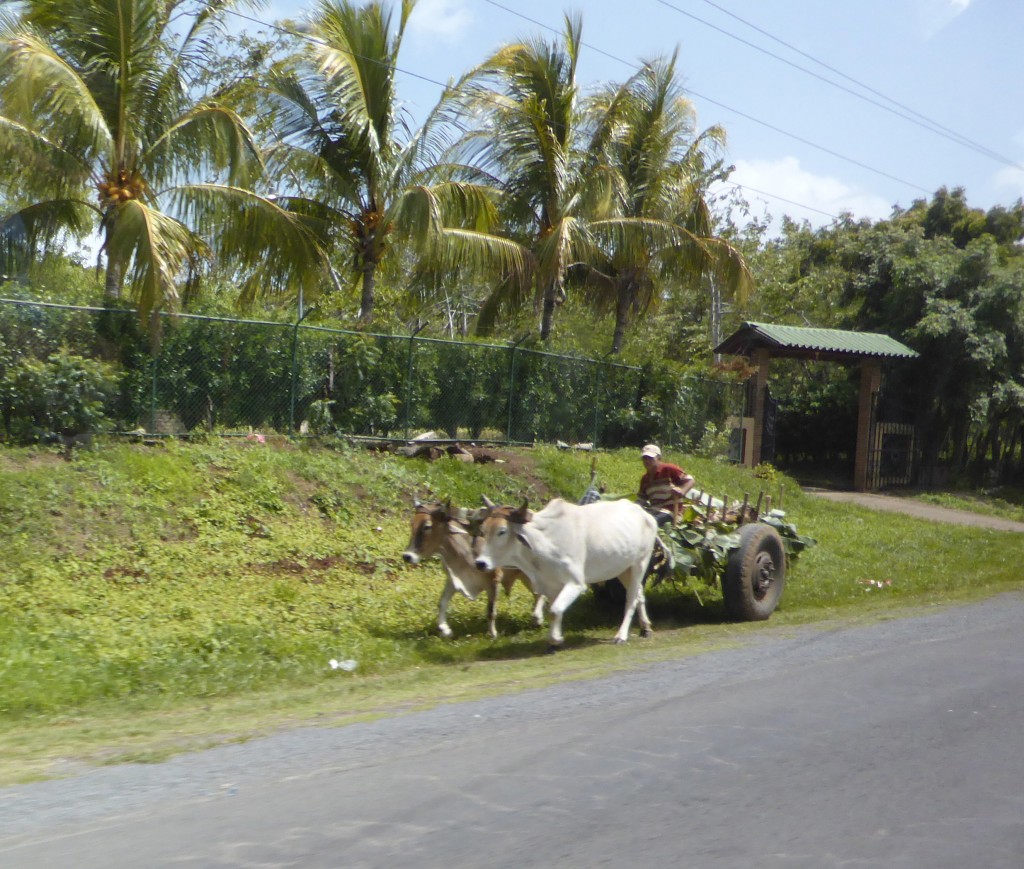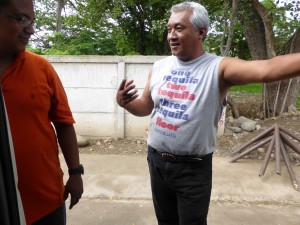Our 3nd day in Kandy, our driver Rohan was anxious to keep us going with a “program” as he called it. Some ideas were the famous botanical gardens and also a tea plantation, with good viewpoints, he said. The previous two days had involved some long car trips so we were looking for something local. The kids needed a school day and didn’t like the sound of our options, so we left them behind to their studies (except for Viv) and headed out for some more Sri Lankan adventures. We set out along the narrow, winding, jungle road departing from our hotel on the river, Rohan asked us again about our program. I ix-nayed the botanical gardens (sorry, Mom), wanting a shorter day, so Rohan mentioned that there was a wood carving place along the way to the tea plantation that might be interesting.
We had already purchased a carved wood box, with hidden compartments, and I thought it would be fun to see a gallery where this sort of craftsmanship is done. Right at the entrance to Oak-Ray Woodcarvings, there was an imposing 6 foot carved elephant, and he and I exchanged a flirtatious glance as I trailed behind the shop salesmen and guide, Joshua, down a side alley into the entrance of the woodshop. He showed us the different kinds of wood that they use. There are actually over 300 types of trees in Sri Lanka, but most of the carving is Teak, Ebony, Mahogany, Coconut, Mara, Jack, and Pathange. The Pathenge tree is a local tree that is $1000 per kilo. What is interesting about it is that they use it to make natural dyes. The guide shaved some sawdust into a cup and demonstrated that adding hot water creates a red color, adding lemon juice makes it purple, and took it through some more fascinating color changes. Obviously items dyed that way are expensive due to the materials used! It is also the dye that was used in the frescoes we saw at Lion Rock where we had climbed yesterday. Once inside the shop, we saw all sorts of furniture that was begging to come home with us. But I knew. It was going to be an elephant. When I showed Jon that it could stand in our entry as a bench for removing shoes, the adoption was as good as done. Viv wrote a little post about it here.
The Ceylon tea shop was on the top of a hill, as promised, with great views of lush tropical hillsides. On the way up the road, we saw teenage boys walking with homemade kites. I wondered where they flew them, as we were surrounded by jungle, but we never did see that spot or get to photograph the kites in flight. But back to the tea….it is a major export from here, brought to Sri Lanka by a scottish guy – James Taylor who brought seeds from India and started the plantings and the entire industry here. The railroads were actually built here to carry the tea to ports where it could be exported. Our familiar and ubiquitous Lipton tea is a product of Ceylon tea in Sri Lanka.
Tea plants live up to 50 years, and the leaves are cultivated, so some of the older plants have huge root systems, like this one in the Ceylon Tea Museum
The tea tour was short and sweet – basically showing us some of the very old equipment historically used in different phases of tea production: withering, rolling, fermentation, drying, and sorting. While in the gallery, Viv walked up to a display case of tea pots and cups from around the world, and she pointed out one from Turkey, which I took as proof that she is recalling stuff from past countries we have visited and relating it to our future travels. At the end, there was no tasting, much to our disappointment!
These are some of the Tamil women who pick the tea leaves. Like most photos taken of people here, it cost us a few well-spent rupees.
Rewind just a bit to the first stop of the day, the woodshop. As we filled out paperwork for our giant elephant souvenir, out came the tea to celebrate the sale along with Joseph and Kelum, the owner. It got me thinking about the ritual of tea that we have encountered in so many countries. The US and some European countries seem to be coffee-predominant but elsewhere in the world, tea is the hot drink of choice. I began to recall some of my favorite ‘tea time’ memories from our travels. In Turkey, there is the omnipresent apple tea, not really a tea, but more of a powdered drink. But we enjoyed it many times, especially at our favorite carpet store, Ikman’s in Goreme with our friends Suleyman and Bilal. Another memory is our daily tea time on the Summerlove boat in southern Turkey, which we shared with our six friends from around the world as we huddled in the shade of the boat’s canopy while floating in some crystal blue harbor. Another variety of tea is the mint tea of Morocco. This was a loose leaf tea, with sweet syrup and mint leaves steeped in the pot, and part of the ritual is the high altitude pour, the pot lifted high above as the brew arcs down into the waiting teacup target. Our surf instructor, Rachid, invited us to share some tea with him after surfing each day in Essaouira, but my favorite Moroccan tea was brewed by our host in Casablanca. Jon and I had left the kids at the Riad we were renting from them, and found our way to their restaurant in the labyrinth of the medina below. His restaurant served one dish each night, and as locals walked in, he would just cook up a dish and bring it out to them, no words exchanged. After we inhaled our delicious shrimp tagine (at 10 pm), we settled back to watch some bad Bruce Lee voiceover (with arabic subtitles) on his TV and he asked us if we’d like some tea. Of course we would, so he quickly dashed out of his shop and disappeared around the corner, only to return 2 minutes later with a bag. He had gone out and bought an orange and some mint, and brewed us the most delicious tea. Had it not been the night before a travel day, I probably would have ordered another pot. The Sri Lankans like it strong, and Kelum at the wood shop told us that it is also customary to not have “preflavored” tea but that they sometimes will add ginger or cinnamon to the cup. No matter the preparation, I love how tea as a social conduit transcends all cultures, how it is used as a means of inviting friends and strangers alike to a conversation. In fact before we left Sri Lanka, we were once again lured away from a walk on the beach to enjoy a pot of tea with a local guest house proprietor – he talked about Sri Lanka, its civil war, its tsunami, its laws and its people, and in exchange we answered many questions about ourselves. This cup was brewed strong in the traditional manner and had fresh chopped ginger in it and a slice of lime. We have experienced that time and again in our travels and as we are now heading into Asia, I imagine there will be many more cups of tea in our futures.





1 ping
Chilling in Chiang Mai » Roaming Jones
January 11, 2014 at 9:40 am (UTC 0) Link to this comment
[…] the pool, where the kids have spent some time in between their studies and reading. Remember my Sri Lanka post about the tea? They serve us tea every afternoon in an adorable little elephant tea pot and cups, […]